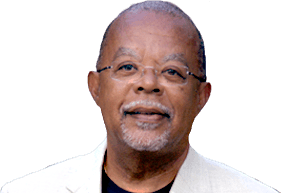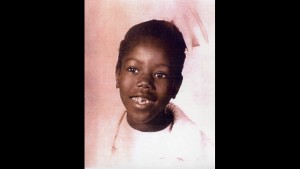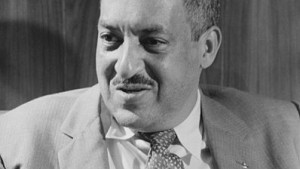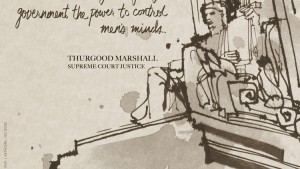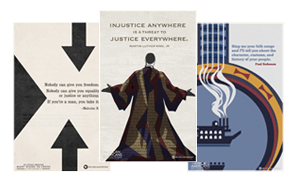Ruby Bridges Goes to School
Ruby Bridges Desegregates a School
On the road to Civil Rights, even children became public figures, such as six-year-old Ruby Bridges, who integrated an all-white elementary school in New Orleans on November 14, 1960. Four years later, Norman Rockwell depicted her brave act of just walking to school, escorted by federal marshals, in a painting, “The Problem We All Live With.” Episode Five: Rise! includes historic footage of Ruby Bridges’ first day at school and a conversation with her today.
When recalling the first trip to her school, Ruby Bridges recalls today, “I saw barricades and police officers and just people everywhere. And when I saw all of that, I immediately thought that it was Mardi Gras. I had no idea that they were here to keep me out of the school. ”
Six years earlier, after decades of struggle, the NAACP had won a major legal victory in the Supreme Court, represented by then-lawyer Thurgood Marshall, a future U.S. Supreme Court Justice. In Brown vs. Board of Education, the Supreme Court declared that the doctrine of separate but equal schools was unconstitutional. For years after the ruling, the South simply refused to integrate. Ruby became one of six New Orleans children chosen to desegregate several all-white elementary schools in the city.
Of the people who gathered at the school to taunt her, Bridges says, “They didn’t see a child. They saw change, and what they thought was being taken from them. They never saw a child.”
The story of Ruby Bridges and desegregation is part of Rise!, Episode Five of the six-part series, The African Americans: Many Rivers to Cross with Henry Louis Gates, Jr. Episode Five premieres on PBS on November 19, 2013, 8-9 pm ET. Check local listings on the broadcast schedule.
Ruby Bridges Desegregates a School
On the road to Civil Rights, even children became public figures, such as six-year-old Ruby Bridges, who integrated an all-white elementary school in New Orleans on November 14, 1960. Four years later, Norman Rockwell depicted her brave act of just walking to school, escorted by federal marshals, in a painting, “The Problem We All Live With.” Episode Five: Rise! includes historic footage of Ruby Bridges’ first day at school and a conversation with her today.
When recalling the first trip to her school, Ruby Bridges recalls today, “I saw barricades and police officers and just people everywhere. And when I saw all of that, I immediately thought that it was Mardi Gras. I had no idea that they were here to keep me out of the school. ”
Six years earlier, after decades of struggle, the NAACP had won a major legal victory in the Supreme Court, represented by then-lawyer Thurgood Marshall, a future U.S. Supreme Court Justice. In Brown vs. Board of Education, the Supreme Court declared that the doctrine of separate but equal schools was unconstitutional. For years after the ruling, the South simply refused to integrate. Ruby became one of six New Orleans children chosen to desegregate several all-white elementary schools in the city.
Of the people who gathered at the school to taunt her, Bridges says, “They didn’t see a child. They saw change, and what they thought was being taken from them. They never saw a child.”
The story of Ruby Bridges and desegregation is part of Rise!, Episode Five of the six-part series, The African Americans: Many Rivers to Cross with Henry Louis Gates, Jr. Episode Five premieres on PBS on November 19, 2013, 8-9 pm ET. Check local listings on the broadcast schedule.
Find educational resources related to this program - and access to thousands of curriculum-targeted digital resources for the classroom at PBS LearningMedia.
Visit PBS Learning Media